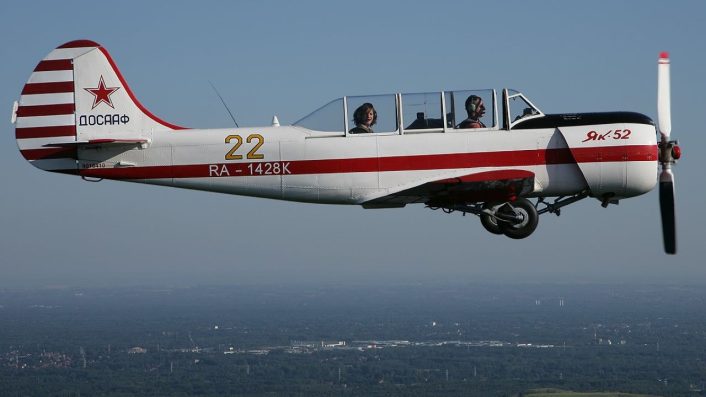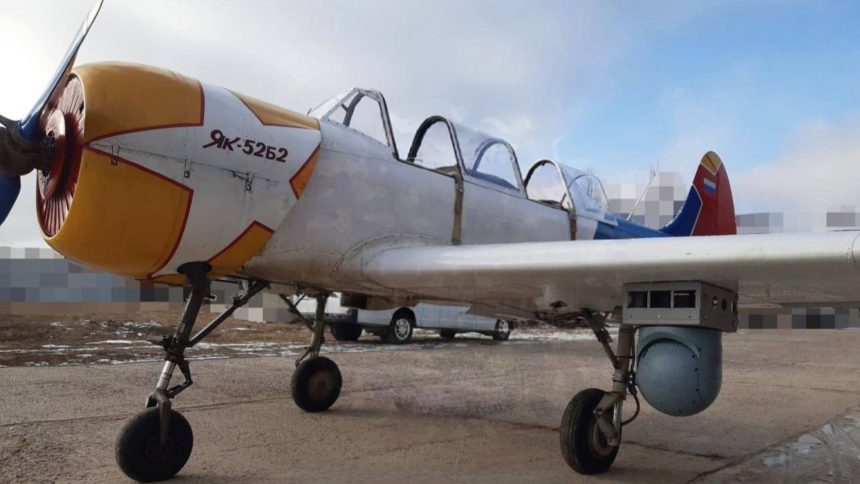The aircraft is intended to intercept Ukraine’s large and diverse array of long-range unmanned systems that are used to strike deep into Russia.
The first images of Russia’s Soviet-era Yak-52 trainer aircraft modified to the Yak-52B2 standard for the airborne intercept of pesky Ukrainian long-range attack UAVs have emerged. The development comes nine months after Ria Novosti reported the effort being undertaken by the Aviasroitel Design Bureau, which is similar to Ukraine repurposing its own Yak-52s for such a role
The tandem-seat aircraft has received a digital flight instrument display, a 12-gauge Saiga semi-automatic shotgun strapped under the starboard (right) wing, and what is reported to be a PEGRAM S400 electro-optical turret under the port wing. Leading Kremlin-aligned Telegram channel ‘Milinfolive’, that first published the images, claimed that the Soviet experience in the 1980’s Afghan war against the Mujahideen was “taken as a basis for the modernization.”
A Russian Yak-52B2 light-engine aircraft modified to shoot down Ukrainian long-range UAVs.
The aircraft is equipped with a PEGRAM S400 comprehensive surveillance system to detect UAVs, a modified cockpit, and a Saiga-12 12mm automatic shotgun to shoot them down.
Add us on… pic.twitter.com/Vo6WmxsIJq
— Uncensored News (@uncensorednews9) May 18, 2025
Another video captured from an accompanying aircraft showed the first example of the Yak-52B2 in flight, checking the new systems’ performance and validating the aircraft’s flight characteristics. The aircraft in that video however appears to have three propeller blades and a fairing on the propeller hub, while the images of the parked Yak-52B2 show an exposed propeller hub and two blades. The rear fuselage is blurred to hide the aircraft registration, and it is therefore not clear if it is the same aircraft, or if more than one plane has been modified.
🛡️🇷🇺Yak-52B2’nin uçuş görüntüleri https://t.co/d39f9sAKbU pic.twitter.com/oo64s5IPF1
— Defence Turk (@Defence_Turk) May 19, 2025
Yak-52B2 features
As we can see in the images, Russian designers decided to retrofit the aircraft with an existing and popular small arm like the Saiga-12, used by many police Special Weapons and Tactics (SWAT) and counter-terror units, instead of installing a machine gun embedded inside the wing’s leading edge. That would have entailed a complex and costly engineering effort to redesign the airframe.
A button on the control stick inside the cockpit should mechanically operate the trigger on the Saiga. The pellets released from the shotgun shells allow for more general and less accurate aiming, with even a few of the ball bearings tearing through a UAV’s soft body disabling it. Mentioning that the “existing fleet of Yak-52 aircraft allows scaling this project,” ‘Milinfolive’ claimed the Yak-52B2 can carry a payload of “90 kg” under each wing. The number of Yak-52s available in Russia for the modification is unclear.
Regardless, this suggests the example seen in the images could be the first prototype, with more advanced features on subsequent airframes. ‘Milinfolive’ claimed the Yak-52B2 carries a “circular scanning radar operating in air-to-air, air-to-ground and weather radar modes,” although other sources described it as the PEGRAM S400 Electro-Optical system.

“The aircraft is equipped with an on-board computer, which generates, among other things, targeting information, and a modern flight and navigation system, which allows flights to be carried out during the day and at night, in simple and difficult weather conditions,” Milinfolive added. The Yak-52B2 would coordinate and prioritize targets with the point-defence Close-In Weapons System (CIWS) like the hybrid gun-missile Pantsir, and the short-range quick reaction Tor-M2, in addition to Electronic Warfare (EW) systems like the Krasukha and LEER that target the UAV’s GPS links.
Ukrainian drones
‘Milinfolive’ specifically identified Ukrainian drones like the An-196 Liutyi and the Aeroprakt A-22 light aircraft – the latter which The Aviationist had identified as a Ukrainian manufactured Sky Ranger Nynja – as the targets for the Yak-52B2.
Ukrainian ground crew and their AN-196 Lyutyy long-range attack drone, ready to launch on a deep strike into Russian territory. pic.twitter.com/vC9M46v0yJ
— OSINTtechnical (@Osinttechnical) April 29, 2025
The Liutyi was first introduced by Ukrainian state concern Ukroboronprom in Oct. 2022. Ukraine claimed in Nov. 2024 the use of an upgraded variant with a payload capacity of 75 kg, over the previous 50 kg, and a range of at least 1,000 km. A strike on Russia’s Engels air base, that hosts its Tu-160 bombers, on Mar. 20, 2025 was followed by overhead videos of an An-196 heading towards the location.
Telegram channel ExileNova+ says Russia’s Engels airbase was targeted by the An-196 Liutyi drones pic.twitter.com/hBnAnovZHH
— Euromaidan Press (@EuromaidanPress) March 20, 2025
The Sky Ranger Nynja, converted into an unmanned aircraft, was captured in images that surfaced on Russian social media on Apr. 26, 2024, crashed in a field somewhere in Russia. The aircraft, that some also claimed is a variant of the A-22 Foxbat, called E-300, was equipped with a single OFAB-100-120 aerial bomb, secured to a rail under the fuselage, and an EO/IR turret.
A Ukrainian E-300 enterprise fixed wing long-range UAV crashed in Russia, 1000 km from the border. Russian media write a camera was installed and that it carried a FAB-100 aerial bomb.
Deeper and deeper. pic.twitter.com/aaSHGmP6Gu
— NOELREPORTS 🇪🇺 🇺🇦 (@NOELreports) April 25, 2024
Challenges
Reloading the Saiga-12 shotgun remains a challenge as, assuming a special high-capacity magazine has not been designed for the purpose, the crew would have to land the aircraft after every few shots and manually reload the gun. However, the rear-seated crew member could also carry an assault rifle – or another Saiga-12 – to engage a larger number of drones.
The video of the Yak-52B2 in flight does show another crew in the tandem seat, however the role is unclear. A wing-mounted gun is also a more efficient system than a sole rear gunner, which restricts the field of fire and exposes the risk of accidental fire on the wings.
Lastly, Ukraine’s ability to rapidly field advanced cheap long-range UAVs, largely without NATO assistance, and commercial drone technology should also be taken into account, and a day won’t be far where Kyiv would launch a larger drone swarm towards Moscow to overwhelm even the Yak-52B2s. The program’s success rests upon how fast Russia modifies its existing Yak-52s, given it took nine months to produce one example, and churns out upgrades.









